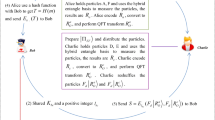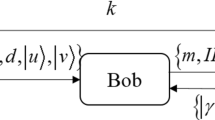Abstract
Blind quantum computation allows a client without quantum abilities to interact with a quantum server to perform a unconditional secure computing protocol, while protecting client’s privacy. Motivated by confidentiality of blind quantum computation, a blind quantum signature scheme is designed with laconic structure. Different from the traditional signature schemes, the signing and verifying operations are performed through measurement-based quantum computation. Inputs of blind quantum computation are securely controlled with multi-qubit entangled states. The unique signature of the transmitted message is generated by the signer without leaking information in imperfect channels. Whereas, the receiver can verify the validity of the signature using the quantum matching algorithm. The security is guaranteed by entanglement of quantum system for blind quantum computation. It provides a potential practical application for e-commerce in the cloud computing and first-generation quantum computation.


Similar content being viewed by others
References
William, S.: Cryptography and Network Security: Principles and Practice, 2nd edn., pp 67–68. Prentice Hall, New Jersey (2003)
Cao, Z.J., Liu, M.L.: Classification of signature-only signature models. Sci. China Ser. F-Inf. Sci. 51, 1083–1095 (2008)
Zeng, G.H., Keitel, C.K.: Arbitrated quantum-signature scheme. Phys. Rev. A 65, 042312 (2002)
Chaum, D.: Blind signature for untraceable payments. Advances in cryptology, proceeding of Cryptology 82, 199–203 (1982). New York
Zeng, G., Lee, M., Guo, Y., He, G.: Continuous variable quantum signature algorithm. Int. J. Quantum Inf. 5(4), 553–573 (2007)
Wang, Y., Xu, K., Guo, Y.: A chaos-based arbitrated quantum signature scheme in quantum crypotosystem. Int. J. Theor. Phys. 53(1), 28–38 (2014)
Siavash, K., Ali, Z.: A sessional blind signature based on quantum cryptography. Quant. Inf. Process 13, 121C130 (2013)
Wang, T.Y., Cai, X.Q., Zhang, R.L.: Security of a sessional blind signature based on quantum cryptograph. Quant. Inf. Process 13, 1677–1685 (2014)
Grover, L.K.: A fast quantum mechanical algorithm for database search. In: Proceedings of the twenty-eighth annual ACM symposium on Theory of computing. ACM, pp 212–219 (1996)
Arrighi, P., Salvail, L.: Blind quantum computation. International Journal of Quantum Information 4(05), 883–898 (2006)
Childs, A.M., Inf, Secure assisted quantum computation. Quantum Comput. 5, 456 (2005)
Broadbent, A., Fitzsimons, J., Kashefi, E.: Universal blind quantum conputation. Proc. of the 50th Annual IEEE Sympo. on Found. of Comput. Sci., 517 (2009)
Guo, Y., Zhao, Y.: High-efficient quantum secret sharing based on the Chinese remainder theorem via the orbital angular momentum entanglement analysis. Quantum Inf. Process 12(2), 1125–1139 (2013)
Li, Q., Chan, W.H., Wu, C.: Triple-server blind quantum computation using entanglement swapping. Phys. Rev. A 89, 040302 (2014)
Morimae, T., Fujii, K.: Blind topological measurement-based quantum computation. Nat. Commun. 3, 1036 (2012)
Mantri, A., Pérez-Delgado, C.A., Fitzsimons, J.F.: Optimal blind quantum computation. Phys. Rev. Lett. 111, 230502 (2013)
Morimae, T., Fujii, K.: Blind quantum computation protocol in which Alice only makes measurements. Phys. Rev. A 87, 050301 (2013)
Morimae, T.: Verification for measurement-only blind quantum computing. Phys. Rev. A 89, 060302 (2014)
Takeuchi, Y., Fujii, K., Ikuta, R.: Blind quantum computation over a collective-noise channel. Phys. Rev. A 93, 052307 (2016)
Barz, S., Kashefi, E., Broadbent, A.: Demonstration of blind quantum computing. Science 335, 303–308 (2012)
Greganti, C., Roehsner, M.C., Barz, S.: Demonstration of measurement-only blind quantum computing. New J. Phys. 18(1), 013020 (2016)
Ekert, A.K.: Quantum cryptography based on Bell’s theorem. Phys. Rev. Lett. 67, 661 (1991)
Author information
Authors and Affiliations
Corresponding author
Additional information
This work was supported by the National Natural Science Foundation of China (Grant Nos. 61272495, 61379153, 61572529).
Rights and permissions
About this article
Cite this article
Li, W., Shi, R. & Guo, Y. Blind Quantum Signature with Blind Quantum Computation. Int J Theor Phys 56, 1108–1115 (2017). https://doi.org/10.1007/s10773-016-3252-z
Received:
Accepted:
Published:
Issue Date:
DOI: https://doi.org/10.1007/s10773-016-3252-z




